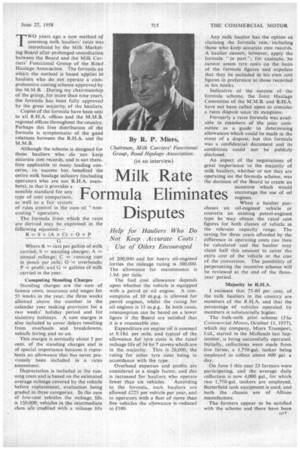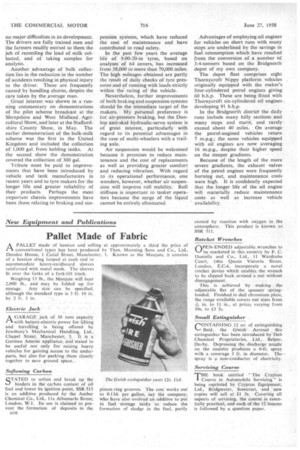T WO years ago a new method of assessing milk hauliers'
Page 59

Page 60

If you've noticed an error in this article please click here to report it so we can fix it.
rates .was introduced by the Milk Marketing Board after prolonged consultation between the Board and the Milk Carriers' Functional Group of the Road . Haulage Association. The formula on which the method is based applies to hauliers who do not operate a cOmprehensive costing scheme approved by. the M.M.B. During my chairmanship of the group, for more than nine years; the formula has been fully approved by the great majority of the hauliers.
Copies of the formula have been sent to all R.H.A. offices and the M.M.B. • regional offices throughout the country. Perhaps this free distribution of the formula is symptomatic of the good relations between the R.H.A. and the M.M.B.
Although the scheme is designed for those hauliers who do not keep accurate cost records, and is not therefore applicable to many leading con-' cerns, its success has benefited the
entire milk haulage industry (including Milk Rate
operators who arc not R.H.A. mem bers), in that it provides a sensible sensible
type of ont domd Pfoi ao, Formula Elimin
as well as a fair system of rates control in the case of "noncosting " operators.
The formula from which the rates are derived may be expressed in the following equation:— Rr S (A X C) 0 P
Where R = rate per gallon of ;milk carried; S = standing charges; A = annual mileage; C running cost in pence per mile; 0= overheads; P = profit; and G = gallons of milk carried in the year.
Computing Standing Charges
Standing charges are the sum of licence costs, insurance and wages for 55 weeks in the year, the three weeks allowed above the number in the calendar year making provision for a two weeks' holiday period and for statutory holidays. A cost margin is also included to cover delays resulting from overhauls and breakdowns, vehicle hiring and so on.
This margin is normally about 5 per cent. of the standing charges and is of special importance because it repreSents an allowance that has never previously been included in a rates assessment.
Depreciation is included in the running costs and is based on the estimated average mileage covered by the vehicle before replacement, evaluation being graded in three categories. In the case of low-cost vehicles the mileage life, is 150,000. vehicles in the intermediate class aie .credited with a mileage life
of 200,000 and for heavy oil-engined lorries the mileage rating is 300,000. The allowance for maintenance is 1.9d. per mile. The fuel cost allowance depends upon whether the vehicle is equipped' with a petrol or oil engine. A consumption of 10 m.p.g. is allowed for petrol engines, whilst the rating for oil engines is 15 m.p.g. In both cases, consumption can be based on a lower figure if the Board are satisfied that it is a reasonable one.
Expenditure on engine oil is assessed at 0.18d, per mile, and typical of the allowance for tyre costs is the rated mileage life of 34 by 7 covers which-are in the majority. This is 26,000, the rating •for other tyre sizes being in accordance with the type.
Overhead expenses and profits are considered as a single factor, and this is increased for hauliers who operate
fewer than six vehicles. According to the formula, such hauliers are allowed £225 per vehicle per year, and to operators with a fleet of more than five vehicles the allowance is -reduced to £180.
Any milk haulier has the option oi claiming the formula rate: including • those who keep accurate cost records. A' haulier cannot, however, apply the formula "in part "; for example, he cannot assess tyre costs on the basis of the formula figures and stipulate that they be included in his own cost figures in preference to those recorded in his books.
Indicative of the success, of the formula scheme, the Joint Haulage Committee of the M.M.B. and RILA. have not been called upon to consider a rates dispute since its inception.
Formerly a rates formula was available to members of the joint committee as a guide' to determining allowances which could be made in the event of a dispute, but this formula was a confidential document and its conditions could not be publicly disclosed.
An aspect of the negotiations of great importance to the majority' of nilk hauliers, whether or not they are operating on the formula scheme, was the decision of the Board to create an incentive which would
atesencourage the use of oil engines. When a haulier purchases an oil-engined vehicle or converts an existing petrol-engined type he may obtain the rated cost figures for both classes of vehicle in the relevant capacity range. The saving for three years afforded by the difference in operating costs can then be calculated and the haulier may claim half this amount to cover the extra cost of the vehicle or the cost of the conversion. The possibility of perpetuating the incentive scheme will be reviewed at the end of the threeyear period.
Majority in R.H.A.
I estimate that 75-80 per cent. of the milk hauliers in the country are members of the R.H.A. and that the percentage of vehicles operated by members is substantially higher.
The bulk-milk pilot scheme (The Commercial Motor, October 11, 1957), which my company, Miers Transport, Ltd., started in the Midlands last September, is being successfully operated. Initially, collections were made from five farms; a 1,750-gal. tanker being employed to collect about 600 gal. a day.
On June I this year 23 farmers were participating, and the average daily collection is now 4,000 gal., for which two 1,750-gal. tankers are employed. Butterfield tank equipment is used, and both the chassis are of Albion manufacture.
The farmers appear to be satisfied with the scheme and there have been n15 no major difficulties in its development. The drivers are fully trained men and the farmers readily entrust to them the job. of recording the load of milk collected, and of taking samples for analysis. , Another . advantage of bulk collection lies in the reduction in the number of accidents resulting in physical injury to the driver. These are frequently caused by handling churns, despite the care taken by the ,average man.
. Great interest was shown in a running commentary on demonstrations of the pilot scheme broadcast at the Shropshire and West Midland Agricultural Show, and later at the Staffordshire County Show, in May. The earlier demonstration of the bulk-milk scheme was the first in the United Kingdom and included the collection of 1,000 gal. from holding tanks. At the second show the demonstration covered the collection of 300 gal.
Tribute must be paid to improvements that have been introduced by vehicle and tank manufacturers in recent years and to tyre makers for the longer life and greater reliability of their products. Perhaps the most important chassis improvements have been those relating to braking and sus pension systems, which have reduced the cost of maintenance and have contributed to road safety.
In the past few years the average life of 9.00-20-in tyres, based on analyses of 64 covers, has increased from 38,000 to more than 70,01:10 miles. The high mileages obtained are partly the result of daily checks of tyre pressures and of running with loads strictly within the rating of the vehicle.
Nevertheless, further improvements of both braking and suspension systems should be the immediate target of the makers. My personal preference is for air-pressure braking, but the Dunlop anti-skid hydraulic-servo system is of great interest, particularly with regard to its potential advantages in the case of multi-wheelers with a trailing axle.
Air suspension would be welcomed because it promises to reduce maintenance and the cost of replacements as well as providing greater comfort and reducing vibration. With regard to its operational performance, one wonders, however, whether air suspension will improve roll stability. Roll stiffness is important to tanker operators because the surge of the liquid cannot be entirely eliminated.
Advantages of employing oil engines for vehicles on short runs with many stops are underlined by the savings -in fuel consumption which have resulted from the conversion of a number of 3-4-tonners based on the Bridgnorth depot of my own company.
The depot fleet comprises eight Thornycroft Nippy platform vehicles originally equipped with the maker's four-cylindered petrol engines giving 60 b.h.p. These are being fitted with Thornycroft six-cylindered oil engines developing 91 b.h.p.
In the Bridgnorth district the daily runs include many hilly sections and many stops and starts, • and rarely • exceed about 40 miles. On average the petrol-engined vehicles .return 7 .m.p.g.; the same vehicles equipped with oil engines are now averaging 16 m.p.g., despite their higher speed on the steeper gradients.
Because of the length of the more severe gradients, the exhaust valves of the petrol engines were frequently burning out, and maintenance costs were high. It is confidently expected that the longer life of the oil engine will materially reduce maintenance costs as well as increase vehicle availability.








































































































































